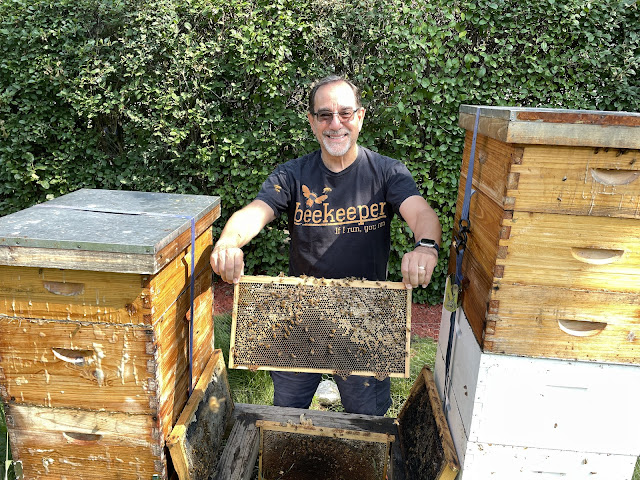 |
| Harrison crib, left, built in 1900; Dever crib is to the right. (Chicago Department of Water Management photo) |
I was chatting Saturday with a young person about, ahem, stochastic mathematics, when the subject strayed to the water intake cribs, the purpose of which she'd recently discovered. I mentioned that I'd visited several of the cribs, years ago, and would dig up that column and share it.
Five big cement trucks floating two miles offshore. A cellular phone with a rotary dial. Gas-powered toilets. Solar electric panels near what might be Chicago's last coal bin still brimming with deep black cubes.
Welcome to the strange world of the Chicago Water Department's six intake cribs, a string of whimsical, round, fortlike structures studding the lake horizon. Cribs that not only serve as the business end of the drinking straw from which the city and 118 suburbs thirstily suck, but offer an odd blend of contradictions: old and new, latest technology and relics of the past.
From north to south, the cribs are: Wilson Avenue, Carter Harrison, William F. Dever, Four-Mile, 68th Street and the Edward F. Dunne. Only Dunne is now drawing from the lake, feeding to the 79th Street water treatment plant.
The Dever crib also was working until July, feeding to the Jardine Treatment Plant north of Navy Pier. Then the 106-year-old tunnel of its adjoining Harrison crib collapsed, threatening the quality of Dever's water and, in the bargain, closing two lanes of northbound Lake Shore Drive until early spring so the shore end of the damaged tunnel can be sealed off.
That's where the cement trucks come in. Not only is the tunnel being bulkheaded off at Chicago Avenue, but also at the Harrison crib, 2 1/2 miles out. The cement workers accompanying the trucks on a barge seemed slightly dazed to find themselves in the middle of the lake.
"This is an extremely odd job, once-in-lifetime job," said Dave Potter, a driver escorting 350,000 pounds of concrete.
Harrison and Dever — the two are connected by a spindly, 30-foot metal walkway — are crawling with activity. Not only do divers wait to funnel the concrete 100 feet down, but electricians are updating the living quarters on Harrison.
Though no longer drawing water, the Harrison crib is being renovated because it still will serve as living quarters. For decades, people lived nearly full time on the cribs — a two-man crew in summer and a four-man crew in winter, plus a cook. The rooms seem from another age: iron beds, a rotary phone (albeit one hooked up to a cell site). The cribs always have been bypassed by time: In 1953, a visiting reporter noted the presence of a tulip-horn Victrola.
In summer, the men scraped debris and hapless crabs and fish from the screens. In winter, they dynamited ice from the intake ports. And year-round, they provided security and monitored a weather station.
The live-in crews are gone now, their duties no longer needed.
Zebra mussels forced the removal of screens over the intakes (debris is now screened out at the treatment plants, where chlorine spray keeps the zebra mussels at bay). Motion detectors provide security. The weather stations are gone.
Still, the living quarters are used, mainly by workmen on major repair projects and those caught on the cribs by storms.
Ice is still a problem, but rather than stay out full time, workers travel to the cribs on the icebreaker James J. Versluis. Ice is kept from the intake ports with the same technology used 100 years ago: one-third sticks of dynamite, lowered on a chain.
Usually the man on the other end of the chain is Ray Perkins, the city's head crib keeper.
"He's our only crib keeper," said Francis Blake, deputy commissioner of the Bureau of Water Pumping. "Our only holdover from that group of guys who used to live on the cribs."
"It was boring," said Perkins, 65, who joined the department in 1956. "Fun at times. When we first started, there was no TV. Mostly radio, and crossword puzzles. Some guys painted. A week out here could be a lifetime."
The history of the cribs is anything but boring, however, rather a wonderful tale of rescues, fires, explosions, high drama and odd events.
Coast Guardsmen with rifles were posted at the cribs during World War II to prevent sabotage. One day in March, 1914, a crib keeper who had drowned the previous November and his successor, who drowned in February, washed up together at Oak Street Beach.
In 1929, a storm so caked one crib with ice that the men inside had trouble breathing. "We were trapped like rats in a caulked barrel," said the keeper.
Then there was the huge alewife assault in the early 1960s.
"Billions of fish out here," remembered Perkins. "We were taking them out in wheelbarrows. Finally there was no place to put them."
Perhaps the dramatic highlight of the cribs occurred in the frigid January of 1948, when single-digit temperatures forced the crews into a 30-hour losing battle with ice. Despite the detonation of 55 sticks of dynamite, the Wilson crib intakes froze completely, cutting water pressure to the North Side.
Just to give an indication of the vital role of the cribs, that drop in water pressure forced schools to close, hospitals to take emergency measures and all Chicagoans north of Fullerton to boil their drinking water.
Until the Harrison tunnel is sealed, the Jardine plant is drawing its daily 750 million gallons of water directly from the lakeshore - the water is dirtier there and costs more to process, which is why the aging cribs, in the relatively clean water several miles out, are still valuable.
Perkins gazed at the small vortexes of water forming on the surface of the interior of the still-active Dunne crib and summed up what all the fuss is about. "You can't do anything without water," he said.
.jpg)


















.jpg)






